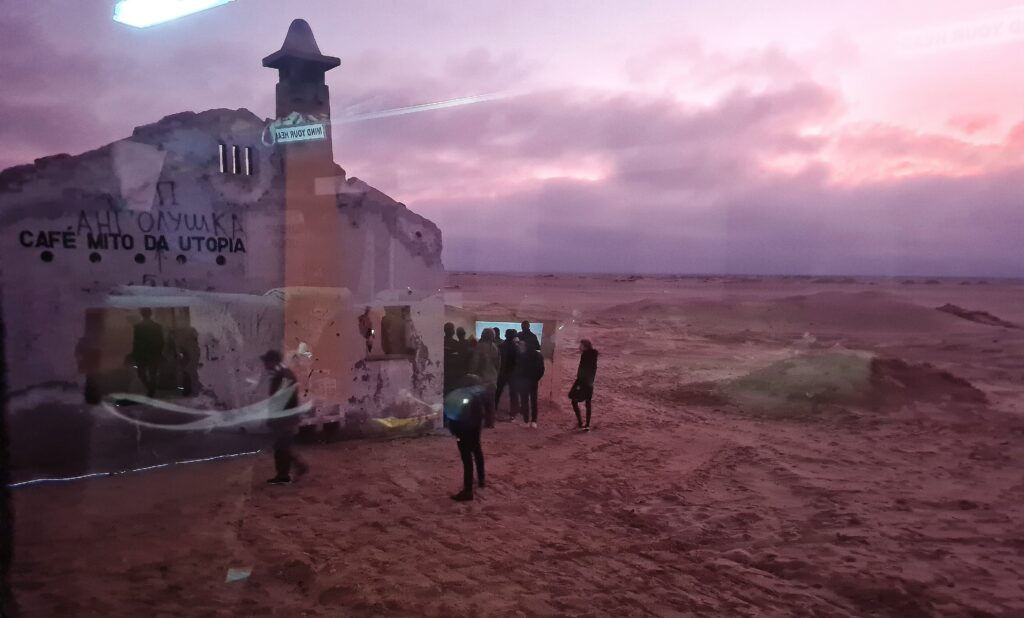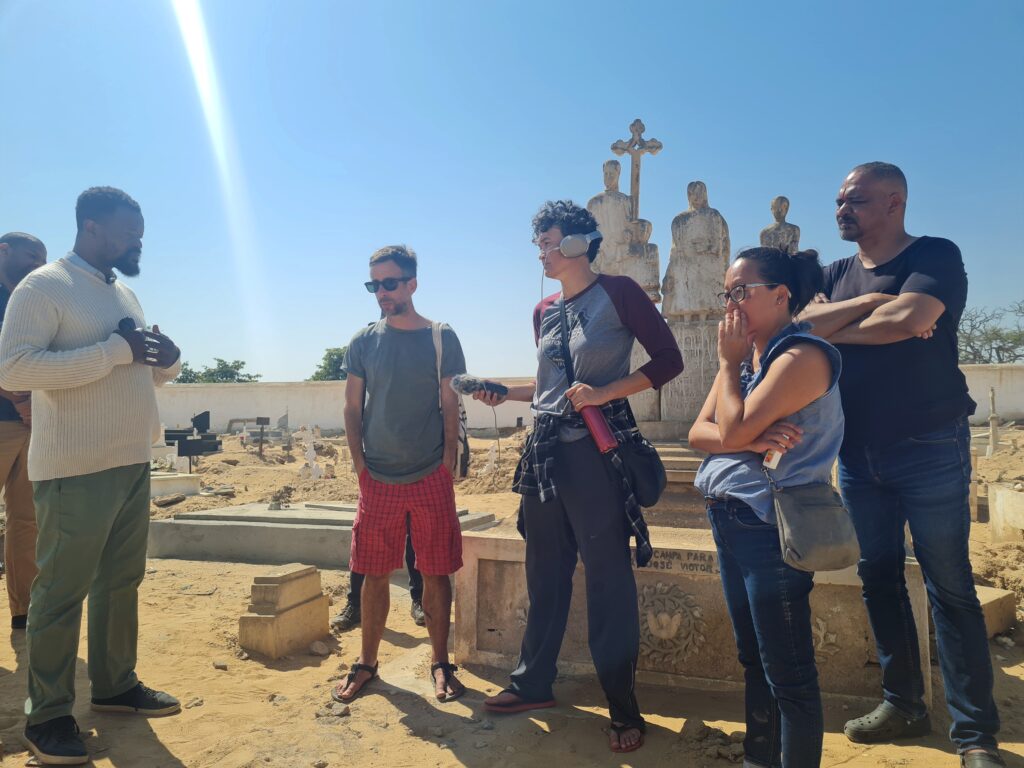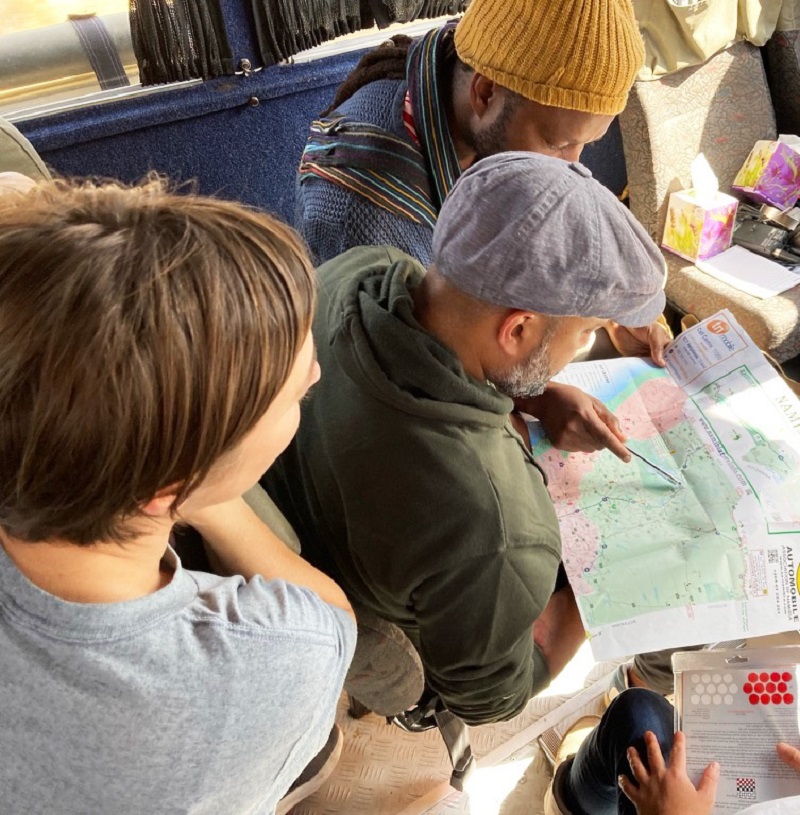Report from a Wenner-Gren Workshop: Speculative Practice and the Politics of the Wayward
Workshop Report
The itinerant workshop Speculative Practice and the Politics of the Wayward took place from the 25 June to the 7 of July 2022 across Namibia and Angola, crossing two borders and driving approximately 2900 km. The workshop brought together an international group of anthropologists, artists, educators and historians and, together, we explored the seams of art, history and anthropology, archive and ethnography, political realism and speculation by opening a set of multimodal propositions to think collectively the aftermaths of colonial and apartheid violence, and the possibilities of moments and practices of waywardness in methodology and politics. Two clear principles animated the workshop: 1) the idea of physically tracing and speculatively mapping a regional landscape of history and politics through encounters with places and people during our journey; 2) the exploration of alternative spaces and new modalities for intellectual conversations and co-productions of knowledge in the wake of Covid19 pandemic and the disruptions that it has brought to tertiary education institutions. Encounters, observations, the movement in and through the landscape, the physical crossing of borders and infrastructures of frontiers, and the embodied experience of postsocialist cartographies, colonial architectures in ruin and landscapes of extraction, allowed us to reimagine and reconfigure, collectively, through modalities and forms akin to ethnography, spatial configurations, networks and unveil hidden connections and multiple temporalities. The workshop was prompted by an invitation from an Angolan artist, Victor Gama, working on the shadows and traces of the life of Angolan anthropologist Augusto Zita N’Gonguenho—to meet, exchange, and develop methods and insights in the desert of Southern Angola where N’Gonguenho had allegedly disappeared in the early 80s.
We deployed a multimodal approach to extensively document our workshop and our journey. Our aims to document—using video, photography, and audio recordings—were twofold. On the one hand, we wanted to create opportunities—using sound, photo, and video—to reach different publics and establish conversations outside the academic spaces. On the other hand, we wanted to create a speculative archive of the scholarly works that have been individually and collaboratively produced for and during the journey. With regards to the former, we collaborated with the Angolan journalist, filmmaker and photographer Francisco Keth, who is producing a documentary of our journey through Angola. We also are working in collaboration with the PanAfrican Space Station (https://panafricanspacestation.org.za/) to broadcast some of our daily recordings in the coming months. With regards to the latter, we now have a robust archive from which we will develop the next iteration of our journey in various forms, including a collected volume, and a multimedia installation.

Bus Worlding
We have started to think of our bus-centered exchange as a kind of worlding practice. Worlding, as Gayatri Spivak (1999) originally theorized, are the ways the colonial powers created a recognizable colonial space through various disciplined forms of knowledge. In more recent iterations, worlding has been utilized as a way towards engaging, for instance, with urban change in Asia as an emergent and spatially specific processes that exceed narrow 20th century conceptualizations of subjectivity and place (See Ong and Roy, 2011). We pick up worlding to consider the bus as a worlding practice—a way to spatialize through collective travel—shared and distinct histories of colonialism as they unfold in situ. Drawing from previous experiments in bus worlding, we have begun to think of the bus as a particular, intensified space of pedagogy and knowledge production, one that pushes well beyond the limits of the academic conference form. Given the distances between sites, and the state roads and infrastructures in the region, we traveled by bus every day, for long hours and great distances. The hours spent together in movement granted us extended time to engage with each other’s works and reflect on the journey and on the encounters made.
Alongside the main presentations—which were given in the form of “plain” talks, devoid of any technological supplements, and that allowed us to rediscover fundamental practices of speaking and listening, of questioning and arguing—we also engaged in collective readings of different sources in multiple languages—academic journal articles, novels, poetry, historical biographies, photographs and maps—and in informal discussions that spontaneously happened on the bus, prompted by the landscape, the talks, the encounters. Furthermore, talks and presentations were not only offered on the bus, “in movement”, but also in “found” locations by the sides of the roads, in dilapidated houses, outside in open air, in taxis and border waiting rooms, etc.

Wayward Stops
In the first part of the journey we approached discussions around the making of borders through the specific case of the Namibia-Angola border Oshikango-St. Clara with particular attention to a colonial and apartheid history. Through visits to museums and specific historical sites— Independence Museum in Windhoek (Namibia), Nakambale Museum in Olukonda (Namibia),Museum of Namibian Music in Omuthiya (Namibia) and Mandume Ya Ndemufayo memorial in Namacunde (Angola); the examination of visual colonial and postcolonial archives such as theJohn Liebenberg Archive and the Prince Boris photographic collection; and places such as the”Old Location” and the townships hostels for migrant workers in Windhoek, or the Etosha National Park— we explored a long history of practices of making and crossing of multiple borders and the legacies of invisible borders such as the “read line” that traversed northern Namibia.
In the middle part of the journey, we explored more closely speculative methods and practices, interrogating the desert, art, colonial histories, ruins and soundscapes, following histories that are often unknown and unreported. In the area surrounding Tombua and Môçamedes, we worked on two specific trajectories: the Mbali community and the anthropologist Augusto Zita. The history of the Mbali, African-Brazilian, community of Môçamedes was introduced to us by the intervention of the local architect Carlos Major, who has been working on the conservation of sections of the Môçamedes municipal cemetery and the study and preservation of sculpted tombstones of indentured labourers and slaves that were imported from Brazil by colonial administrators at the beginning of the 20th century. What kind of speculations can be produced starting from funerary art produced around colonial experiences of subjection? The second trajectory was the one of the ghostly figure of the Anthropologist Augusto Zita N’Gonguenho and that we explored in conjunction with the exhibition “tecktonik:TOMBWA – Café Mito da Utopia”. Conceived by Victor Gama, in collaboration with South African writer Stacy Hardy, Angolan architect and curator Paula Nascimento, film-maker and photographer Kiluanje Liberdade and photographer, filmmaker and journalist Francisco Keth Pedro, with the support of the Centro de Estudos do Deserto (CEDO) in Curoca, Movimento Lev’Arte in Tombwa, the Prince Claus Fund & Goethe Institute, and with the assistance of the Academia de Pescas e Ciências do Mar, Provincial Government of Namibe and Huíla and the Municipal Administration of Tombwa, the Café was constituted as a research site to explore what an anti-colonial project for ethnography might look like and rethink radical methodologies in relation to fragments, shadows and ghosts, poetry, art and film. We also had several talks on the history of the relationship between anthropology and surrealism, exploring surrealist apprehension of “reality”, art and political possibility. We hosted a workshop on visuality that explored images from colonial archives at the intersection with issues of race, gender and violence, we explored the potentialities of speculative practices in creating unexpected connections and new understanding of social and historical life.
The landscape of the desert constituted a crucial space of reflection, of walking and writing, of starting to imagine a PanAfrican archive of transborder African sounds and music. The visit to the Instituto Superior de Ciências de Educação da Huíla, Department of Conservation and Biology, in Lubango, and the encounter with biologist Prof Fernanda Lages helped us to understand the biological continuity existing across borders.
The final theme approached during the workshop centered on waywardness and politics in the wake of the failure of conventional 20th century and Cold War political formations. Following closely the history of the liberation struggles of lusophone African countries, such as Angola, Cabo Verde and Mozambique, and the socialist trajectories of these countries, as well as the liberation movements in Namibia and the Black Consciousness tradition in South Africa, we discussed specific experimental politics that emerged around the continent in the 1950s and 1960s and that provided creative, alternative ways to rethink contemporary African politics.

Reorientations/next steps
We are currently working on reassembling this experiential workshop towards an edited, multimedia book. We plan to reconvene participants of Speculative Practice and the Politics of the Wayward – hopefully at a manuscript development workshop at the Society for Advanced Research in Santa Fe—to consolidate the publication. We wish to express our deep gratitude to the Wenner-Gren Foundation for the support and interest in this project, which was a transformative intellectual event for all involved.
Participants and talks
Asfaw Semeneh Ayalew (Institute of Ethiopian Studies, Addis Ababa) “Radical compassion as a political principle against the failure of conventional politics”
Ethiraj Gabriel Dattareyan (Department of Anthropology, NYU) “Prince Boris and the Liberal Gaze: Speculative interventions in the colonial archive”
William Ellis (Department of Anthropology, University of the Western Cape) “Introduction to the unethical theory and method in the practice of a plantology: a parody of volkekunde as plantologie”
Jung Ran Forte (Department of Anthropology, University of the Western Cape) “‘One and one make three and two and two make five:’ speculative practices, divination and objets trouvés”
Kelly Gillespie (Department of Anthropology, University of the Western Cape) “Cesaire|Frobenius: Anthropology and the Surreal”
Patricia Hayes (Centre for Humanities Research, University of the Western Cape) “The Making of the Bush of Ghosts”, “Reading photographs”
Paolo Israel (Department of History, University of the Western Cape) “The War of the Magic Lions: A tale from Cabo Delgado, Mozambique” (A reading), “Mueda 1960: A politics of improvisation”
Shahram Khosravi (Department of Social Anthropology, Stockholm University) “Borders and ordering”, “Accent as Method”
Leigh-Ann Naidoo (School of Education, University of Cape Town)“The Speculative Vanguard”
Sakaria Jacob Jacks Nashilongwe-Shipwe (University of Cape Town) “ZILIN: Transborder African sound”
Eugene Paramoer “Tracing ancient pathways, journeying with beyond-border warrior spirits” (film screening)
Sonia Vaz Borges (Department of History, Drexel University) “Mangrove School” (film screening),”Walking”